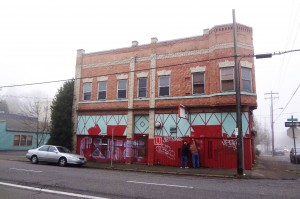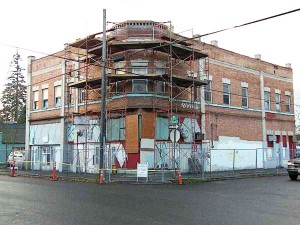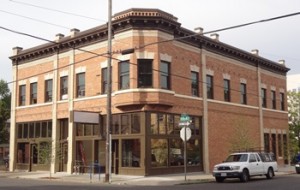Portland’s Rinehart Building was listed on the National Register of Historic Places in December of 2013. Until a few years ago, the building suffered extreme neglect, but its history is incredibly significant.

before work began
(Photos Courtesy Oregon Heritage).

during restoration
(Photos Courtesy Oregon Heritage).

after work was completed
(Photos Courtesy Oregon Heritage).
The Rinehart Building was constructed in 1910 along an important streetcar line in Portland’s historic Albina neighborhood. It is notable as one of the few remaining commercial buildings in Albina associated with the social and cultural fabric of the African American community.
In 1939 Albina was already home to the majority of Portland’s African American population. The number of African Americans in Portland swelled during WWII to fill the large number of war-time shipbuilding jobs, and discriminatory housing practices funneled these new residents to the Albina area. After the war, African American-owned businesses along Williams Avenue flourished.
The Rinehart Building was home to a number of African-American-owned enterprises, including the Cleo-Lilliann Social Club. Begun in the 1950s, the Club served as a community and charitable organization that provided entertainment, social support, and fundraising, and was a forum for community activism. The Club hosted many notable African American musicians, such as B. B. King and George Foreman. When the Club closed in 2001 it was considered to be one of the oldest African American social organizations of its kind in Oregon.
The Browns, who own the building, committed to its restoration. They got a little help in the big project from the State’s Diamonds in the Rough grant program designed to help bring back lost historic character.
Brandon Brown shared his thoughts about the value of the grant on the project.
The Diamonds in the Rough grant really helped us in completing the arduous project that the Rinehart building came to be. We purchased a 1910 structure which was as historically colorful as it was neglected. The biggest piece of our budget was the rehabilitation of the masonry facade. We had some beautiful aesthetic brick to work with, but the costs quickly increased as the coverage of the repointing became more exhaustive and the cleaning of the brick more intense than forecast. Additionally, we had to reconstruct the entire cornice that ran 120 linear feet from a single photograph and install an entirely new storefront.
The grant really helped with our additional expenses. Ultimately we were able to produce a wonderfully historically accurate facade and achieved a spot on the National Historic Register. We’re really proud of our project and thank you for your support.
The deadline for Diamonds in the Rough grant applications is coming soon, March 31.
Editor’s Note
This story originally appeared on the Oregon Heritage Exchange.

